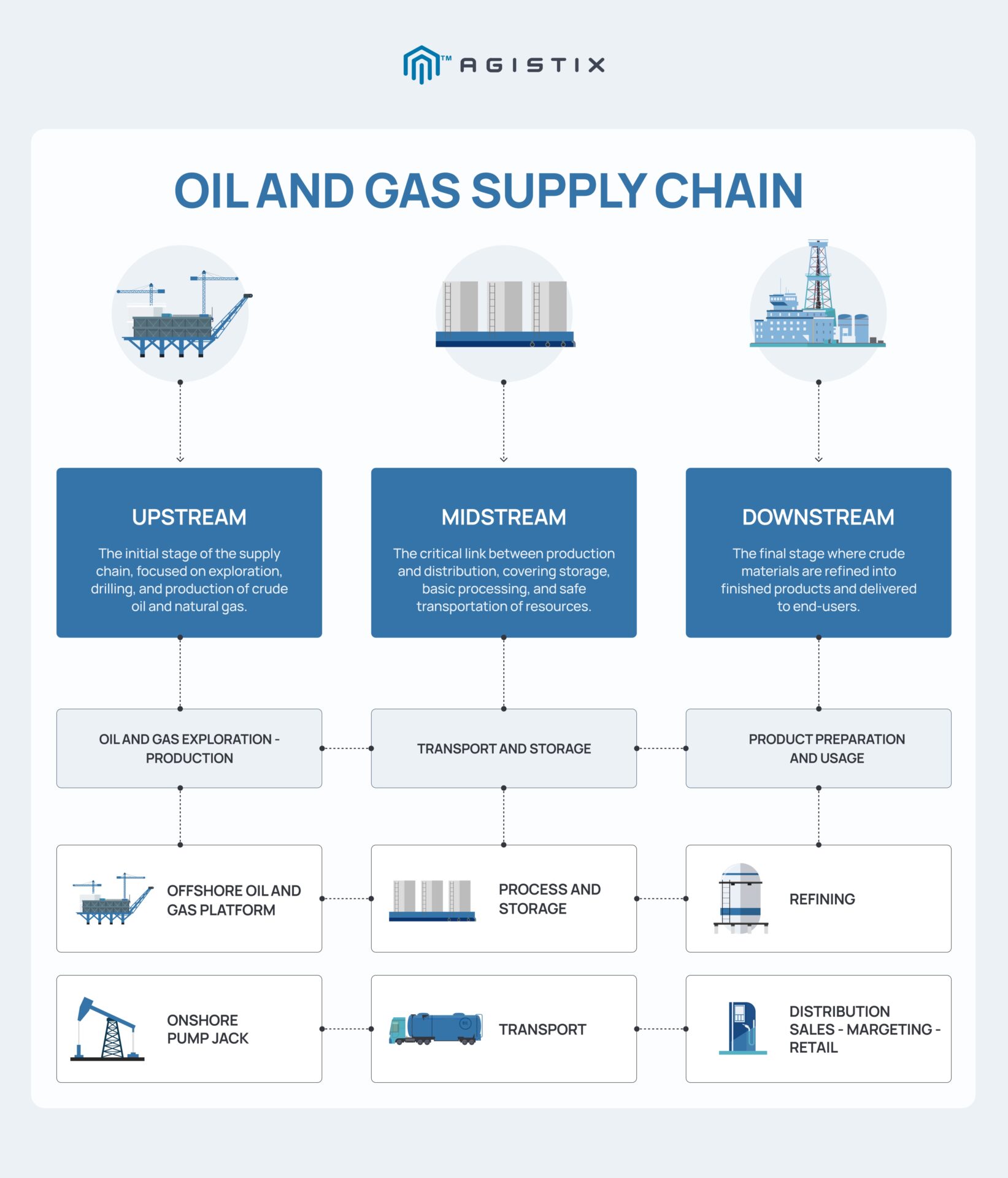September 26, 2025 - 7 minutes read

Optimizing the Midstream Oil and Gas Supply Chain: Best Practices
Oil and gas supply chains are under immense pressure. The ongoing conflict between Russia and Ukraine, as well as instability in the Middle East, has disrupted the fuel trade, forcing oil companies to navigate route closures and increased transportation costs. At the same time, aging infrastructure and rising expectations around emissions are exposing long-standing issues in how oil and gas are stored and moved. Without better coordination and real-time insight, midstream logistics management is often dominated by reacting to problems rather than preventing them.
In this blog, we’ll explore how the midstream oil and gas supply chain works, what’s driving today’s challenges, and how better data and visibility can close the gaps.
What is a Midstream Supply Chain & How Does it Work?
Supply chains in the oil and gas industry are made up of many interconnected stages, each with its own complexities. To understand how midstream operations fit into the larger picture, it’s helpful to break the supply chain into three main segments: upstream, midstream, and downstream.
The upstream segment focuses on the discovery, exploration, drilling, and production of crude oil and natural gas. Midstream includes the storage, processing, and transportation of these resources, and is the critical link between production and delivery. Downstream covers the final stage: refining raw materials and distributing finished products to end-users.
Inside the Midstream Oil and Gas Supply Chain
The midstream segment is responsible for storing, processing, and transporting oil and gas between upstream production and downstream distribution. This stage includes all processes, operations, and equipment required for material distribution.
- Storage: Midstream operations help balance supply and demand by storing crude oil and natural gas in tanks and terminals until they’re needed for downstream sales. This also includes loading systems and transfer equipment used in the distribution preparation process.
- Transportation: Once oil or gas is needed downstream, it’s transported to refineries or processing plants primarily via pipeline—one of the safest and most efficient methods available. In some cases, trucks, barges, or railcars may also be used to support pipeline networks or access remote areas.
- Processing: Before distribution, materials require basic processing to meet safety, quality, or regulatory standards. After this stage, products are routed to warehouses, plants, or distribution facilities using coordinated multimodal transport.
Although it may appear more straightforward than exploration or refining, midstream logistics in the oil and gas industry are highly complex, and companies must navigate strict safety regulations, environmental compliance, and operational risks. Bottlenecks or blind spots in midstream operations can result in delays, financial penalties, or even environmental damage.
Oil and Gas Market Outlook: Supply Chain Pressures and Strategic Priorities
Volatility in the global energy market continues to present challenges for oil and gas logistics, especially in the midstream segment. In addition to infrastructure constraints, rapidly changing tariffs are adding complexity, impacting equipment sourcing, cross-border shipments, and cost structures in ways that are difficult to forecast. Similar pressures are being felt in industries like manufacturing, where tariffs have reshaped sourcing strategies and raised the stakes for supply chain visibility. For oil and gas, staying resilient means rethinking how transportation, storage, and supplier coordination are managed across fragmented networks.
From infrastructure constraints to evolving tariffs and trade dynamics, supply chain disruptions are becoming increasingly frequent and more difficult to predict. To stay resilient, midstream operators need to rethink how they manage transportation, storage, and supplier coordination.
Rising Supply Chain Complexity in a Geopolitically Unstable Market
Global unrest continues to disrupt established energy routes, disproportionately affecting the oil industry supply chain. Ongoing conflict in Ukraine and instability in the Middle East have impacted the flow of crude oil and LNG, contributing to rate volatility and constrained capacity across key corridors. Demand for non-Russian energy sources has shifted export patterns and placed new pressure on ports, pipelines, and storage terminals, particularly in Europe and North America.
According to industry reports by Deloitte, energy supply disruptions and freight rate variability remain top concerns in the years ahead. For midstream operators, this uncertainty makes real-time visibility and flexible logistics planning more important than ever.
Addressing Risk in an Aging, Understaffed Midstream Network
Operational risk is growing across the midstream sector. Aging infrastructure and persistent labor shortages are making it harder to maintain safe and efficient supply chain operations. These challenges increase the likelihood of disruptions, safety incidents, and unplanned downtime.
Many cast and wrought iron pipelines and tank storage systems in the U.S. are over 50 years old and overdue for upgrades. Outdated infrastructure is more prone to damage or leaks and fails to meet new regulatory standards. Without adequate oversight, these outdated structures introduce delays that ripple through the supply chain.
At the same time, talent gaps are putting additional pressure on operations. While 81% of oil and gas executives say their workforce is agile enough to respond to change, just 29% are actively investing in reskilling or retraining efforts. Without a more proactive approach to workforce development, midstream operators risk falling further behind as technology and compliance demands accelerate.
Digitalization and Supply Chain Resilience Move to the Forefront
As disruptions become harder to predict, digital transformation in midstream oil and gas operations is becoming increasingly important for improving agility and control. But technology alone isn’t enough. The value only exists if fragmented systems can be connected—integrating shipment data, carrier updates, storage records, and operational metrics into a single, centralized view.
Without this level of data centralization, teams are left reacting to issues as they arise. McKinsey reports that while many oil and gas companies launch digital initiatives, 70% fail to scale them beyond the pilot phase, which limits their ability to respond when conditions change. Digital solutions for oil and gas offer a comprehensive view of the supply chain, enabling faster decision-making and stronger long-term resilience.
How to Optimize the Midstream Supply Chain
Overcoming oil and gas supply chain challenges starts with gaining control over the systems, processes, and data that drive daily execution. Companies looking to increase efficiency and respond faster to disruption should focus on the following:
- Centralize data from supply chain partners – Integrate shipment data, carrier updates, and invoice information into one platform to eliminate blind spots.
- Invest in real-time visibility tools – Monitor the movement of oil and gas across pipelines, terminals, and multimodal handoffs to catch issues early.
- Standardize documentation and workflows – Establish consistent processes for shipment creation, status updates, and exception handling to reduce delays and miscommunication.
- Strengthen collaboration between upstream and downstream teams – Ensure that production schedules and customer demand are aligned with midstream transportation and storage plans.
- Track performance and identify bottlenecks – Use analytics to monitor throughput, dwell time, and delay frequency. Target areas with recurring issues for process improvements or automation.
Optimizing midstream logistics is less about reinventing operations and more about connecting existing data with the right oil and gas supply chain solutions. With advanced digital tools in place, companies can reduce manual work and build a more resilient supply chain.
How Agistix Supports Oil and Gas Supply Chains
Midstream logistics is increasingly complex, making visibility and coordination critical to operational success. Agistix brings shipment execution and real-time data into one centralized platform, no matter where or how freight is booked. Oil and gas companies can manage transportation across all modes, ensure compliance, and respond faster to disruptions.
The Agistix platform’s capabilities include:
- End-to-end shipment visibility across carriers and modes
- Centralized access to documents, status updates, and exceptions
- Real-time collaboration between internal teams and suppliers
- Analytics tools to support cost control, compliance, and ESG reporting
Agistix makes it easier to eliminate blind spots, improve resilience, and keep operations moving, even in the most volatile conditions.
Ready to simplify oil and gas supply chain management? Request a demo to see Agistix in action.
Frequently Asked Questions


